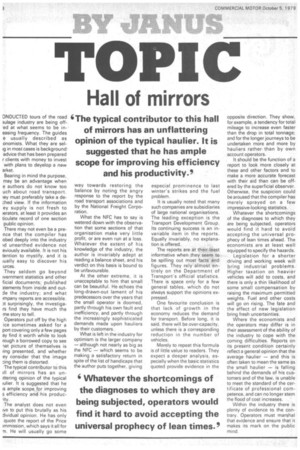TOIPI
Page 60

If you've noticed an error in this article please click here to report it so we can fix it.
Hall of mirrors
The typical contributor to this hall of mirrors has an unflattering opinion of the typical haulier. It is suggested that he has ample scope for improving his efficiency and his productivity., DNDUCTED tours of the road 3ulage industry are being offed at what seems to be ineasing frequency. The guides e usually described as onomists. What they are selig in most cases is background, advice that has been prepared
r clients with money to invest with plans to deyelop a new arket.
Bearing in mind the purpose, may be an advantage when e authors do not know too uch about road transport. ley must preferably take a de;'..hed view. If the information ey supply is not fresh to ierators, at least it provides an ticulate record of one section public opinion.
There may not even be a prence that the compiler has obed deeply into the industry td unearthed evidence not eviously available. It is not his tention to mystify, and it is ivally easy to discover his urces.
They seldom go beyond )vernment statistics and other ficial documents; published atements from inside and outde the industry; and what mpany reports are accessible. )t surprisingly, the investigars find they have much the me story to tell.
Operators put off by the high ice sometimes asked for a port covering only a few pages ay find it worth while to look rough a borrowed copy to see ',at picture of themselves is ling presented, and whether ey consider that the image 7,ing them is distorted. .
The typical contributor to this ill of mirrors has an unittering opinion of the typical iulier. It is suggested that he is ample scope for improving s efficiency and his producity.
The analyst does not even lye to put this brutally as his dividual opinion. He has only quote the report of the Price )mmission, which says it all for n. He will usually go some way towards restoring the balance by noting the angry response to the report by the road transport associations and by the National Freight Corporation.
What the NFC has to say is watered down with the observation that some sections of that organisation make very little profit, or are even run at a loss. Whatever the extent of his knowledge of the industry, the author is invariably adept at reading a balance sheet, and his verdict on this basis is bound to be unfavourable.
At the other extreme, it is unacceptable to him that small can be beautiful. He echoes the long-drawn-out lament of his predecessors over the years that the small operator is doomed, partly through his own fault and inefficiency, and partly through the increasingly sophisticated demands made upon hauliers by their customers.
What is left in the industry for optimism is the larger company — although not nearly as big as the NFC — which seems to be making a satisfactory return in spite of the list of handicaps that the author puts together, giving especial prominence to last winter's strikes and the fuel problem.
It is usually noted that many such companies are subsidiaries of large national organisations. The leading exception is the Transport Development Group. Its continuing success is an invariable item in the reports. Equally invariably, no explanation is offered.
The reports are at their least informative when they seem to be spilling out most facts and figures. They rely almost entirely on the Department of Transport's official statistics. There is space only for a few general tables, which do not always support the opinions expressed.
One favourite conclusion is that lack of growth in the economy reduces the demand for transport. Before long, it is said, there will be over-capacity, unless there is a corresponding reduction in the number of vehicles.
Merely to repeat this formula is of little value to readers. They expect a deeper analysis, especially when the basic statistics quoted provide evidence in the opposite direction. They show, for example, a tendency for total mileage to increase even faster than the drop in total tonnage; and for the longer journeys to be undertaken more and more by hauliers rather than by own account operators.
It should be the function of a report to look more closely at these and other factors and to make a more accurate forecast with their aid than can be offered by the superficial observer. Otherwise, the suspicion could be aroused that the compiler has merely sprayed on a few impressive-looking statistics.
Whatever the shortcomings of the diagnoses to which they are being subjected, operators would find it hard to avoid accepting the universal prophecy of lean times ahead. The economists are at least well equipped to specify the hazards.
Legislation for a shorter driving and working week will bring industrial problems. Higher taxation on heavier vehicles will add to costs, and there is only a thin likelihood of some small compensation by raising the maximum permitted weights. Fuel and other costs will go on rising. The fate and the effect of new legislation bring fresh uncertainties.
Where the economists and the operators may differ is in their assessment of the ability of the industry to cope with the coming difficulties. Reports on its present condition certainly reflect a general opinion that the average haulier — and this is often taken to mean the same as the small haulier — is falling behind the demands of his customers and of the law, is unable to meet the standard of the certificate of professional cornpetence, and can no longer stem the flood of cost increases.
Within the industry there is plenty of evidence to the contrary. Operators must marshal that evidence and ensure that it makes its mark on the public mind.




























































































































































